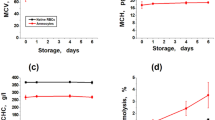Abstract
The biological efficacy of recombinant human hepatic cell line, glutamine synthetase-transfected HepG2 (GS-HepG2), was examined under various culture conditions in large-scale culture. GS-HepG2 (2×109 cells) were cultured in a circulatory flow bioreactor, and the changes in the concentrations of ammonia, glucose, glutamine, and glutamic acid were checked with normal, glutamic acid-insufficient, and glutamine-excess medium or porcine plasma. Whereas the glutamine synthetase reaction required high concentrations of Mg2+ in vitro, GS-HepG2 removed ammonia in the culture medium without the addition of Mg2+. Similarly, ammonia removal activity was observed in the medium with physiological concentrations of glutamic acid far lower than the enzymeK m. Moreover, product-induced inhibition of the enzyme activity was not observed with addition of excess glutamine to the medium. Ammonia removal activity was also detected in porcine plasma at the level equivalent to that in the culture medium. The substrates and cofactors indispensable to the glutamine synthetase reaction were likely to be generated and/or stored inside the cells. Thus, the bioreactor with recombinant cells catalyzes the reaction without the need for added cofactors and substrates and surpasses the enzyme-immobilized system to perform blood dialysis by selective removal of toxic substances.
Similar content being viewed by others
References
Cousineau J, Chang TM. Formation of amino acid from urea and ammonia by sequential enzyme reaction using a microencapsulated multi-enzyme system. Biochem Biophys Res Commun 1977;79:24–31
Enosawa S, Suzuki S, Kakefuda T, Amemiya H, Omasa T, Suga K, Ito N, Kuramochi K. Estimation of ammonia removal activity of glutamine synthetase immobilized gel with the aim of selective detoxification of blood ammonia (abstract in English). Jpn J Artif Organs 1996;25:399–402
Tsuruoka S, Sugimoto K, Ueda K, Suzuki M, Imai M, Fujimura A. Removal of digitonin and doxorubicin by multidrug resistance protein-overexpressed cell culture in hollow fiber. Kidney Int 1999;56:154–163
Enosawa S, Miyashita T, Suzuki S, Li XK, Tsunoda M, Amemiya H, Yamanaka M, Hiramatsu S, Tanimura N, Omasa T, Suga K, Matsumura T. Long-term culture of glutamine synthetase-transfected HepG2 cells in circulatory flow bioreactor for development for a bioartificial liver. Cell Transplant 2000;9:711–715
Enosawa S, Mukaiyama T, Miyashita T, Li XK, Suzuki S, Amemiya H, Matsumura T, Omasa T, Suga K. Application of circulatory flow bioreactor for long-term and large-scale culture of glutamine synthetase transduced CHO cells and its ammonia removal activity with an aim of development for bioartificial liver assist system. J Arif Organs 2001;4:61–66
Matsumura T, Sawai Y, Suzuki J, Fujimori T. Circulatory culture equipment. 1993;U.S. Patent 5270207
Miyashita T, Enosawa S, Suzuki S, Tamura A, Tanaka H, Amemiya H, Matsumura T, Omasa T, Suga K, Aoki T, Koyanagi Y. Development of bioartificial liver with glutamine synthetase transduced recombinant human hepatoblastom cell line, HepG2. Transplant Proc 2000;32:2355–2358
Enosawa S, Suzuki S, Fujino M, Amemiya H, Omasa T, Urayama S, Tanimura N, Suga K. An attempt to add biological functions by genetic engineering in order to produce high-performance bioreactor cells for hybrid artificial liver: transfection of glutamine synthetase into Chinese hamster ovary (CHO) cells. Cell Transplant 1997;6:537–540
Enosawa S, Suzuki S, Kakefuda T, Amemiya H. Examination of 7-ethoxycoumarin deethylation and ammonia removal activities in 31 hepatocyte cell lines. Cell Transplant 1996;5:39–41
Author information
Authors and Affiliations
Corresponding author
Additional information
In the text, the wordammonia is used to include ammonia and ammonium, because although glutamine synthetase metabolizes ammonium, there is an equilibration relation between ammonia and ammonium, resulting in a decrease in the total content of ammonia and ammonium by the enzyme.
Rights and permissions
About this article
Cite this article
Enosawa, S., Miyashita, T., Li, XK. et al. A bioreactor with glutamine synthetase-transfected recombinant HepG2 cells exhibits ammonia removal activity without the need for added cofactors and substrates: Advantage of a cellular bioreactor over enzyme-immobilized beads. J Artif Organs 4, 348–352 (2001). https://doi.org/10.1007/BF02480030
Received:
Accepted:
Issue Date:
DOI: https://doi.org/10.1007/BF02480030




